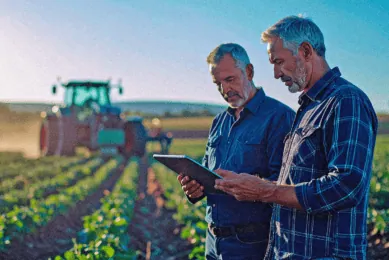‘The Humanoid revolution: A new farmhand with steel muscles?’

In the year 2023, the agricultural sector has undergone a profound transformation, marked by a plethora of innovations ranging from AI-driven agronomists to smart (laser) weed control systems and planters that apply fertilizer measured per seed. But as we draw the curtains on this year, there’s a phenomenon that has largely remained outside our fields and farms: humanoid robots, human-like machines evolving rapidly thanks to AI.
Many of us are familiar with the inspiring images of dancing and leaping humanoids from companies like Boston Dynamics. Tesla recently announced its second-generation Optimus humanoid, which Elon Musk believes will soon conquer the industrial workspace. Musk initially promised these robots would cost less than $ 20,000 in 2022, but it appears that this goal is not achievable, with a price tag closer to $ 100,000.
A $ 150 Billion Market
If more affordable alternatives emerge, they are likely to come from China. China has announced its plans to commence large-scale production of humanoid robots by 2025. Experts predict that the market for these robots could be worth a staggering $ 150 billion annually worldwide within 15 years. They could see widespread use in factories between 2025 and 2028 and expand into various other professions between 2030 and 2035.
Prefer a humanoid over an autonomous tractor
But will these humanoid robots also take center stage in the agriculture sector? Last summer, farmers from the Illinois Soybean Association in the USA visited the Netherlands to witness how agriculture is innovating in the country. During their visit, soybean and corn grower Bryan Severs shared his primary concern regarding automation. “Autonomous tractors and field robots are great, but I‘d prefer a robot that can handle the dirty work on my farm, such as cleaning grain silos and machinery. I can hardly find young employees interested in such tasks anymore.”
So, why not consider deploying humanoid robots in the near future to take over challenging and unpleasant tasks from workers who are no longer enthusiastic about these roles, especially in rural areas? It seems like an enticing prospect, having a farmhand who never complains and is ready to carry out any task 24/7.
Humanoid robots aren’t cleaning machines yet
To answer this question, I consulted Dutch robot expert Erik Pekkeriet, Program Manager for Vision + Robotics at Wageningen University. Pekkeriet offers a pragmatic perspective, stating, “Technological development is advancing rapidly, but I see complexities within the agricultural sector that cannot be easily addressed with a humanoid. Let’s embrace the development but also focus on solving immediate challenges with robust and creative solutions, ‘beyond human capabilities.‘”
To gain a comprehensive view, I also sought the insights of Prof. Dr. Ir. M. (Martijn) Wisse, Director of the TU Delft Robotics Institute. Wisse provides a similarly grounded perspective, saying, “I believe the rise of humanoid robots isn’t as widespread as some claim. The ‘hype’ resembles that of Honda’s ASIMO robot 20 years ago. The European RoboCom++ humanoid project also has a 15-year history. In short, the emergence of humanoid robots is less revolutionary than some think.”
Maybe the humanoid will surprise us later
While heavy physical labor has largely been automated, challenges and opportunities persist in integrating humanoid robots into agriculture. For technological adaptations, these robots may need to resemble humans more closely to effectively operate in the same environments.
All in all, it seems that humanoid robots may not yet take on a prominent role as farmhands. Still, let’s keep the door open for new ideas and innovations. Agriculture stands at the brink of a new revolution, and while the possibilities appear endless, patience might be the key to their ultimate success. Do you have a different perspective? Share it with us via futurefarming@misset.com.
The Future Farming Newsletter
Sign up for our newsletter and receive all our need-to-know content three times a week.
Join 17,000+ subscribers
Subscribe to our newsletter to stay updated about all the need-to-know content in the agricultural sector, two times a week.



